Today, March 2nd, 2010, it reached 46 F (7 C) and after a brief mild spell, some of the glacier-like deep crust of icy snow receded, beginning to reveal bare ground and overwintered plants. I am always interested in testing claims that plants are evergreen and are able to withstand a tough New England winter. I snapped a few photos of plants I have grown for at least several years. I'll start out with some Epimedium species.
1. Epimedium wushanense "Spiny-leaved form" - with lustrous spiny leaves, Nov. 18, 2009.
2. Epimedium wushanense "Spiny-leaved form" - came through like many "eppies", a bit tatty, but respectable. On the many evergreen Epimediums species, I make a judgement each spring whether to shear off all old foliage, or just tidy up a bit and snip away and of the dead or winter-burned leaves.
3. Epimedium wushanense "Spiny-leaved form" - beautiful flowers yet to come, photo from March 2009.
4. Epimedium lishichenii - bold, shiny, rugose, deeply veined leaves, Nov. 18, 2009.
5. Epimedium lishichenii - again looking a bit tatty today, but not bad. Most leaves will be left on.
6. Epimedium lishichenii - in April-May, fresh lime-green rugose growth above old foliage, large yellow spidery flowers.
7. Epimedium pubigerum - taken today, the best looking and most winter tolerant of the epimediums, the foliage still in very good form.
8. Epimedium pubigerum - flowering on April 15th 2009 (tax day), in this photo one gets the 3-tier effect, with the older darker leaves at the base, a solid foundation for the new growth of lighter fresh green red-tinged foliage, topped with dainty heuchera-like sprays of small white flowers.
9. Epimedium pubigerum - like most "eppies", there is an ornamental second flush of foliage soon after flowering, with light color-suffused foliage overtopping the earlier, now darker green foliage.
Comments
Re: Evergreen plants after a New England winter
The leaves on most of mine look rather less than even "decent" after the snow melts off...
Just reading about that one, now, Rick... By the way, Stearn shows the spelling as "lishihchenii"... ?
His description is of evergreen leaves, "coriaceous (leathery-textured) when mature", "upper side dark green, the lower side glaucous and with long multicellular hairs, or almost glabrous". If yours has pubescence (short soft hairs) on both sides of the leaves, it makes one wonder... ? On the other hand, the lobes of the terminal leaflet are supposed to be equal and obtuse, while those of the lateral leaflets are very unequal, etc.... that seems to fit. And the flowers do seem to match, as well, as you noted.
Re: Evergreen plants after a New England winter
Rick, in general characteristics your plant does look like E. lishihchenii. As Lori mentioned, referencing Stearn, if the leaves are pubescent on the upper surface of the leaves, then maybe the plant is something else... perhaps even a hybrid, or the species is more variable than we realize? In your second photo, it is sort of hard to tell, but the leaves look coriaceous and do not look pubescent.
I actually prefer the species to which it always gets compared to, E. membranaceum, which I will show in another thread.
Re: Evergreen plants after a New England winter
If the evergreens are covered with snow all winter, they should tolerate cold weather pretty well! I have tried Epimediums and they usually overwinter well, but slugs eat the new growth of many species so they tend to disappear after 2-3 years (or I have to start with huge plants which is not possible). My remaining Epimediums and other evergreens are still covered by 2ft of snow. My Eucryphia looks devastated but the Mahonias seem to have taken the winter weather well.
Pics from last year.
Re: Evergreen plants after a New England winter
If the evergreens are covered with snow all winter, they should tolerate cold weather pretty well! I have tried Epimediums and they usually overwinter well, but slugs eat the new growth of many species so they tend to disappear after 2-3 years (or I have to start with huge plants which is not possible). My remaining Epimediums and other evergreens are still covered by 2ft of snow. My Eucryphia looks devastated but the Mahonias seem to have taken the winter weather well.
Pics from last year.
Trond, both are gorgeous, if only they'd grow here. There are a few Mahonia that'll survive here, but they generally look so battered and wind-burned, that they never look as good as they would in a more suitable climate. And the Eucryphia, such beauties they are. I just google searched, and most are listed as USDA Zone 8 (I'm Zone 5 here, much colder), with lots of nurseries and wonderful cultivars in the UK or on the European continent. Closer to Boston, Massachusetts, which has the mitigating temperature influence of the Atlantic ocean, it is a full zone warmer (Zone 6) than where I am, just 40 miles northwest of Boston. In the suburbs of Boston, or Boston proper, I often see large and beautiful evergreen Ilex species and cultivars, whereas these things typically winterburn so badly here it is not worth bothering with them.
Re: Evergreen plants after a New England winter
Here are three more plants that prove reliably evergreen through New England winters.
1. Ophiopogon (NOT)chingii - aff. umbraticola - This little treasure from China is widely available from mailorder nurseries under the name Opiopogon chingii. The problem is, it is clearly misidentified, as O. chingii is a larger stoloniferous plant with broad flat leaves, completely unlike the subject plant which is a dwarf clumper with thread-narrow leaves that coil around to form a small green bird's nest. See illustration of the true O. chingii in Flora of China:
http://www.efloras.org/object_page.aspx?object_id=60757&flora_id=2
The plant is much closer to O. umbraticola. There are 47 Ophiopogon species in China (so far) and it is a difficult group. I have brought this to the attention of Tony Avent, an Ophio-king :D , to see what he can determine. The plant looks as spritely after a hard winter as it did in the fall.
2. Ophiopogon (NOT)chingii - aff. umbraticola - I missed seeing the subtle midsummer pinkish-white flowers, but in late October it can surprise with the most brilliant shiny blue berries ever.
3. Ophiopogon (NOT)chingii - aff. umbraticola - Closer view of the berries.
4. Tofieldia coccinea variety - one of those quietly modest plants but such a "good doer" in the garden, growing in shade or sun (mine is in shade), but never complaining about moisture levels (although supposed to prefer moist conditions). The tiny flowers on short stems are whitish to pinkish or reddish, but I like it for the reliable miniature fans of foliage, looking quite good after winter. There are a number of varieties of coccinea, I do not know which one I have, I was given the plant as "T. coccinea var." I'm interested in knowing if others grow this, as it is a circumpolar plant.
5. Iris henryi - one of the Chinese Iris treasures recently introduced into the USA by Darrell Probst. I took a cue from how Darrell grows his plants (and most of his Epimediums too), planting them on enbankments. Iris henryi is effective planted this way, as the very narrow foliage mass cascades down the slope, looking like a Carex species. The spring flowers are exquisite, palest smokey blue with yellow signal spots. It is increasing well, and I must dig it up and divide (and extricate the Epimedium davidii that has invaded the clump).
6. Iris henryi - flowering early to mid May, 2006
7. Iris henryi - flowering early to mid May, 2008, the clump has increased a lot.
Re: Evergreen plants after a New England winter
Well, Mark, I have always thought that you had a better winter climate there than I have here! But you have at least much warmer summers. Although I can grow some USDA zone 8 plants it is many I can't grow due to lack of summer warmth. Redbud for instance is not good here, too cool summers.
But what about this one: Chrysosplenium macrophyllum, wintergreen or rather winterred! Should be in flower now, but as I have told: snow snow snow...
It has big red leaves in winter.
PS! I like your Irises, never seen them before.
Re: Evergreen plants after a New England winter
Well, Mark, I have always thought that you had a better winter climate there than I have here! But you have at least much warmer summers. Although I can grow some USDA zone 8 plants it is many I can't grow due to lack of summer warmth. Redbud for instance is not good here, too cool summers.
But what about this one: Chrysosplenium macrophyllum, wintergreen or rather winterred! Should be in flower now, but as I have told: snow snow snow... It has big red leaves in winter.
I really must try some of these Chrysosplenium plants, rather intriguing look to them with colored leafy bracts... nice. I have only tried one Japanese species decades ago when I lived in Washington State (Pacifis Northwest of USA). What is so interesting about a forum like this, it opens one's eye to see new things, or serve as a reminder of plants one should be growing. I had never seen C. macrophyllum before, seems like a good one for all season color.
And speaking about the experience of living in two dramatically different climates (mild west coast versus harsher northeastern USA), is that there are plants that behave exactly as you mention, failing to grow well, or failing to even prove hardy, in a milder climate, because of the lack of summer warmth and hardening off in the fall.
Trond, maybe the sun will come out and start melting the snow, spring is around the corner.
Re: Evergreen plants after a New England winter
Trond, maybe the sun will come out and start melting the snow, spring is around the corner.
Mark, I really hope so. In fact we have had more sun than usual, but the air is Siberian cold and has been so for almost 3 month! But the sun is low in the sky, remember, I live far north. You have to go as far as Hudson Bay or southern tip of Greenland, or Anchorage, Alaska, to get about at the same latitude.
Re: Evergreen plants after a New England winter
Trond, that Chrysosplenium macrophyllum is very cool. I remember those pics of Ophiopogon from somewhere, Mark, and they captivate me now just as they did before. The Iris henryi, I can see, might look a little out of place if not sited correctly for aesthetics. On an incline is a perfect place. Very nice.
Hey look at this http://home.earthlink.net/~darrellpro/ .
E. lishihchenii looks just like mine.
I have to say though, that pubescence isn't the right word, as the short hairs are very stiff and give a rough feel to the leaf.
Re: Evergreen plants after a New England winter
Hey look at this http://home.earthlink.net/~darrellpro/ .
E. lishihchenii looks just like mine.
I have to say though, that pubescence isn't the right word, as the short hairs are very stiff and give a rough feel to the leaf.
Hiya Rick, yes I know the URL well, Darrell Probst lives about 35-40 minutes from me, and it has become a annual ritual to place an order each spring then attend one of his several "Open Nursery" days in May each year to pick up the order, buy more plants, and view the nursery beds. To see rows upon rows of Epimedium treasures, unreleased new species and amazing hybrids is such a mind-bending experience. And Darrell and Karen are always so accomodating to answer questions and offer vital information. As I like to say, we have a special situation where the world's Epicenter of Epimedium is right here in the heart of Massachusetts.
So, our plants come from the same source. Be aware however, that in the case of E. lishihchenii, Garden Vision Epimediums (the new nursery name, now run by ex-wife Karen Perkins, although Darrell is still contributing to the effort) list this species as "several clones/Cc. numbers", which is to say, the sale of this plant is represented by a number of variable collections, but without highly identifiably different characteristics to warrant separating them out. In the case of some "eppie" species, like E. grandiforum f. flavescens, he sells 9 different forms, and now 4 different forms of pubigerum (I have all of them with which to compare), so I trust the level of observation and judgement. In just a few weeks, when spring truly arrives, I shall look at my E. lishihchenii for the stiff hairs, maybe they're present in mine but I just haven't looked closely enough. Overall though, I'd say our plants generally match.

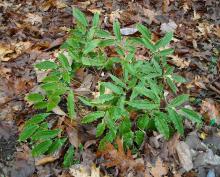



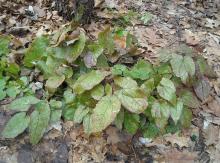
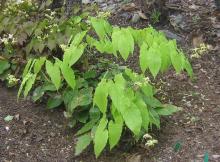
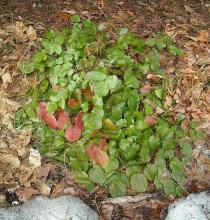
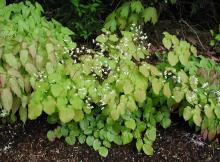
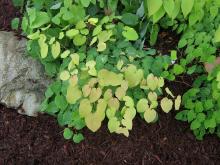
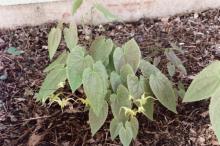
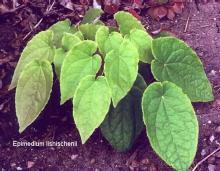

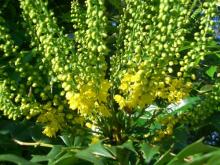


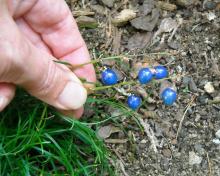

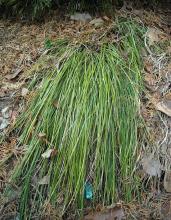
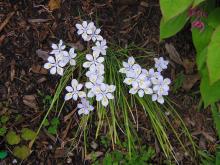
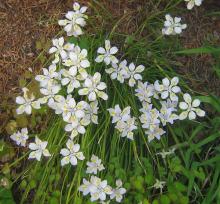
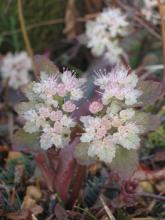
My Epimediums' foliage look decent right after the snow melts too, but as spring progresses, last year's leaves look pretty terrible. I always end up cutting them down in my colder zone. Our spring winds are much drier than yours out east.
I have Epimedium lishichenii, or so it said. The flowers seem to match, but the foliage is decidedly dull, due to the heavy pubescence over the entire leaf. Sometimes the new foliage will have a pinkish/bronze tone.
Any thoughts?